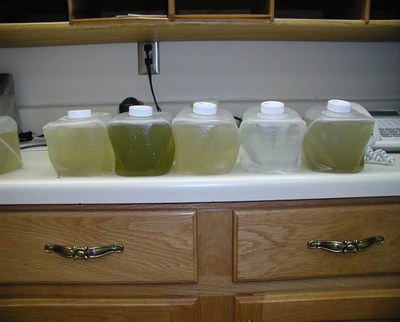Pasture Water Testing Advised This Year
6/1/15
Pastures were drier than usual this early spring and water pond levels were lower. Recent rains have recharged these stock ponds. However, some stock ponds are still at low water levels.
Without snow melt and limited early spring rains, stock ponds at low levels have less water to dilute salts and solids. If these salts and solids are too high in concentration, cows and calves will grow poorly, eventually quit drinking that water and possibly die.
Cattle often indicate which water is acceptable through preferring one water source over another when given a choice. While watching animal behavior might provide some insight to water quality, testing water by a water testing laboratory is quicker and more definitive.
Several tests can be used to determine if water is acceptable for cattle. The most common test to determine suitability for livestock is Total Dissolved Solids (TDS). TDS measures all solids (mostly salts) that are present in the water sample after the water is evaporated. ‘Salt’ includes various mineral salts including sodium chloride (NaCl or table salt).
Mature cattle might tolerate TDS up to 10,000 ppm for a limited time but with continued use will affect health and production. A safe acceptable concentration of TDS is 3,000 ppm or less. Various livestock water samples in Foster County have tested less than 1000 ppm. However, stock ponds recharged with runoff water can have higher TDS; especially in late summer when pond water levels have dropped due to evaporation .
Sulfates are one of the dissolved solids. High sulfate concentration will have a laxative effect, electrolyte imbalance, and mineral tie-up. The acceptable limit is 0-500 ppm sulfates. Water intake is reduced with high sulfate water. Water high in sulfate may have a rotten egg odor.
Nitrates may also be a problem in water. Water from a watershed that has been heavily fertilized with nitrogen fertilizer or manure may be high in nitrates. Nitrate-nitrogen concentration should be less that 100 ppm with caution advised at 100-300 ppm NO3-N.
Testing for bacterial microorganisms is common for human water sources and dairies. Coliforms should not be present in human drinking (potable) water. However, beef cattle tend to drink pond water that may contain coliform bacteria. Fecal coliforms are an indication of poor water quality. As fecal coliforms rise, the color and smell of the water will change and cattle will avoid drinking from these ponds if possible.
Water can be tested for water quality at the ND Department of Health and at various commercial feed testing laboratories. At the ND Department of Health, a one quart jar of water is needed for mineral chemistry (including TDS - Total Dissolved Solids). The address for ND Department of Health Chemistry Services is at https://www.ndhealth.gov/chemistry/SERVICES/SERVICES.HTM.
If water TDS is too concentrated, cattle will require another water source. This may include drilling a new well, piping rural water, hauling water, or abandoning the pasture.
(Picture: example of 1 quart water sample size.)

| TDS – Total Dissolved Solids (ppm or mg/L) | |
|---|---|
|
Less than 3000 |
Usually satisfactory for most livestock |
| 3000-5000 |
May not cause adverse effects to adult livestock. Growing or young livestock may be affected with diarrhea or poor feed conversion. |
| 5000-7000 |
Should not be used for pregnant or lactating females. Usually laxative and expect reduced water intake. |
| 7000-10,000 |
Do not use for swine. Do not used for pregnant or lactating ruminants or horses. |
| 10,000 or more | May cause brain damage or death. |
Karl Hoppe
Area Specialist, Livestock Systems
Area Specialist, Livestock Systems


